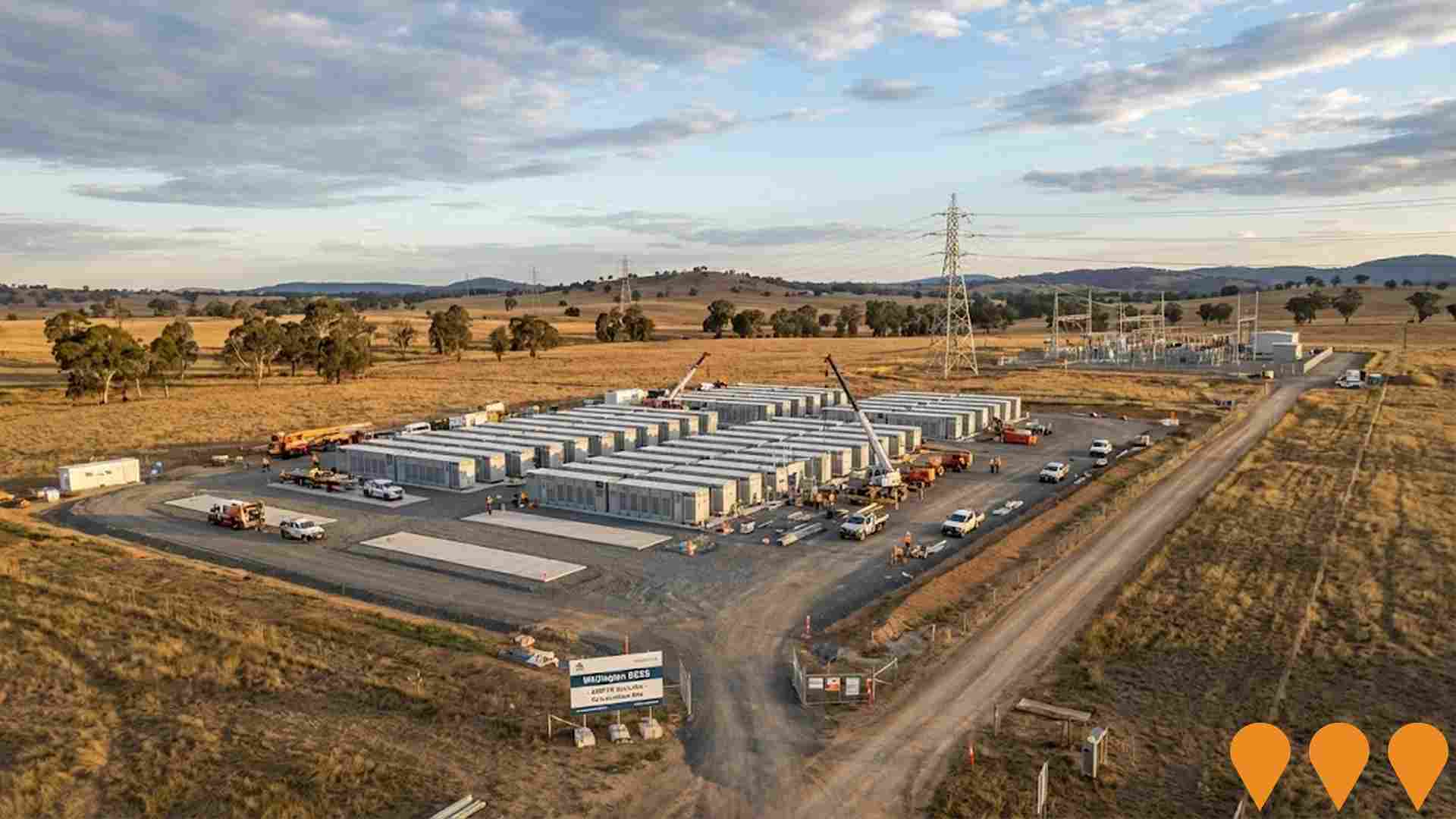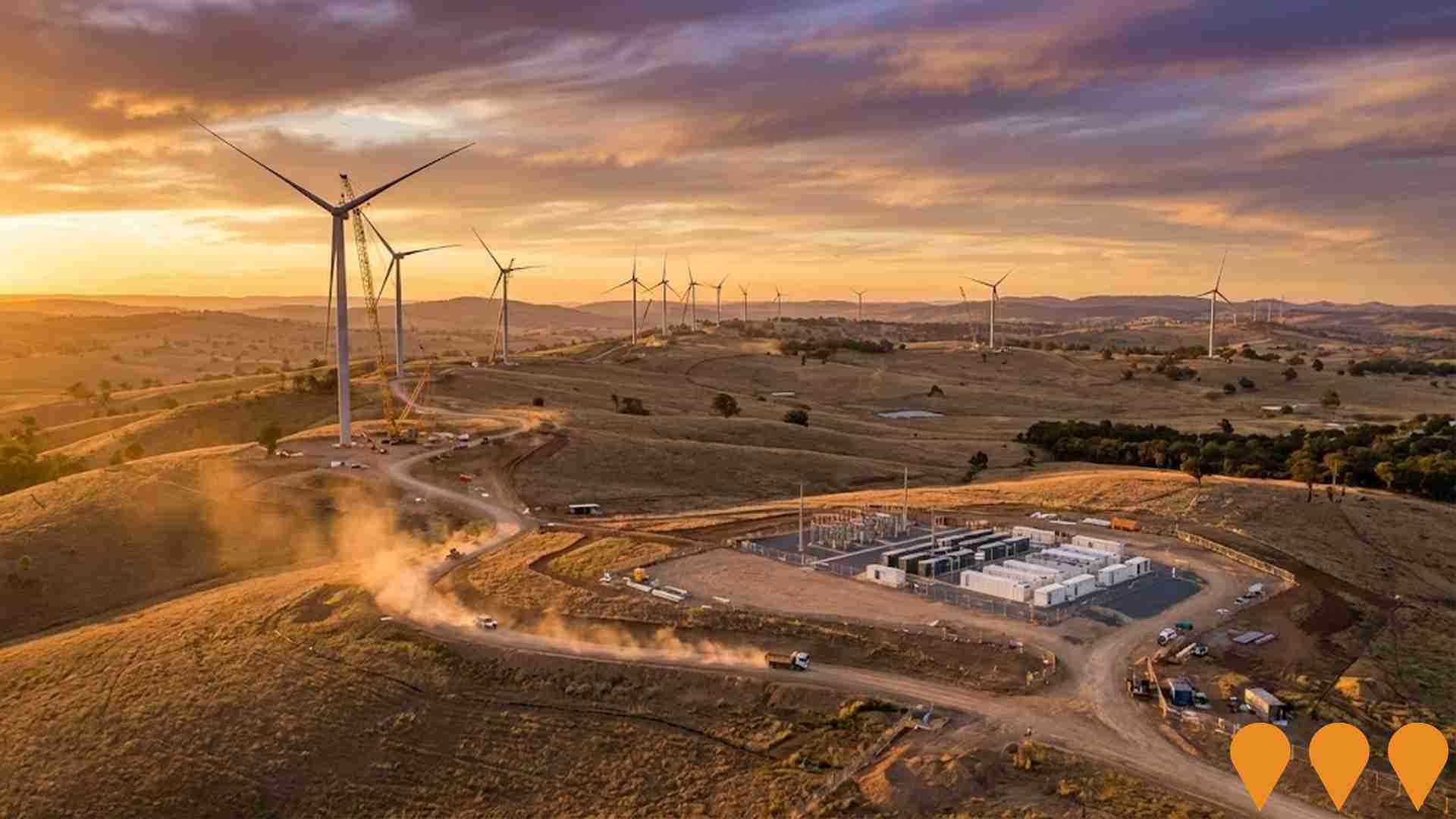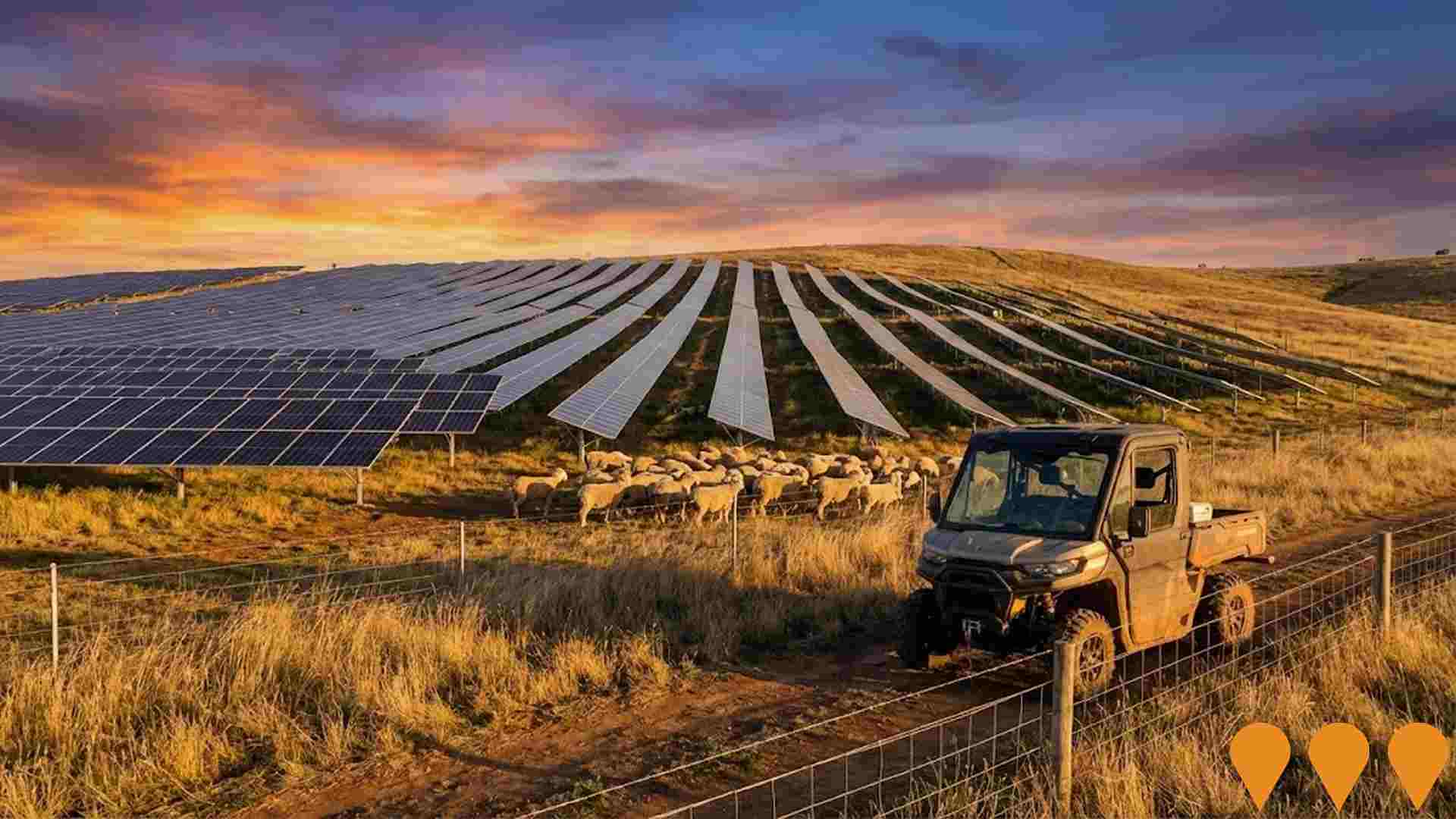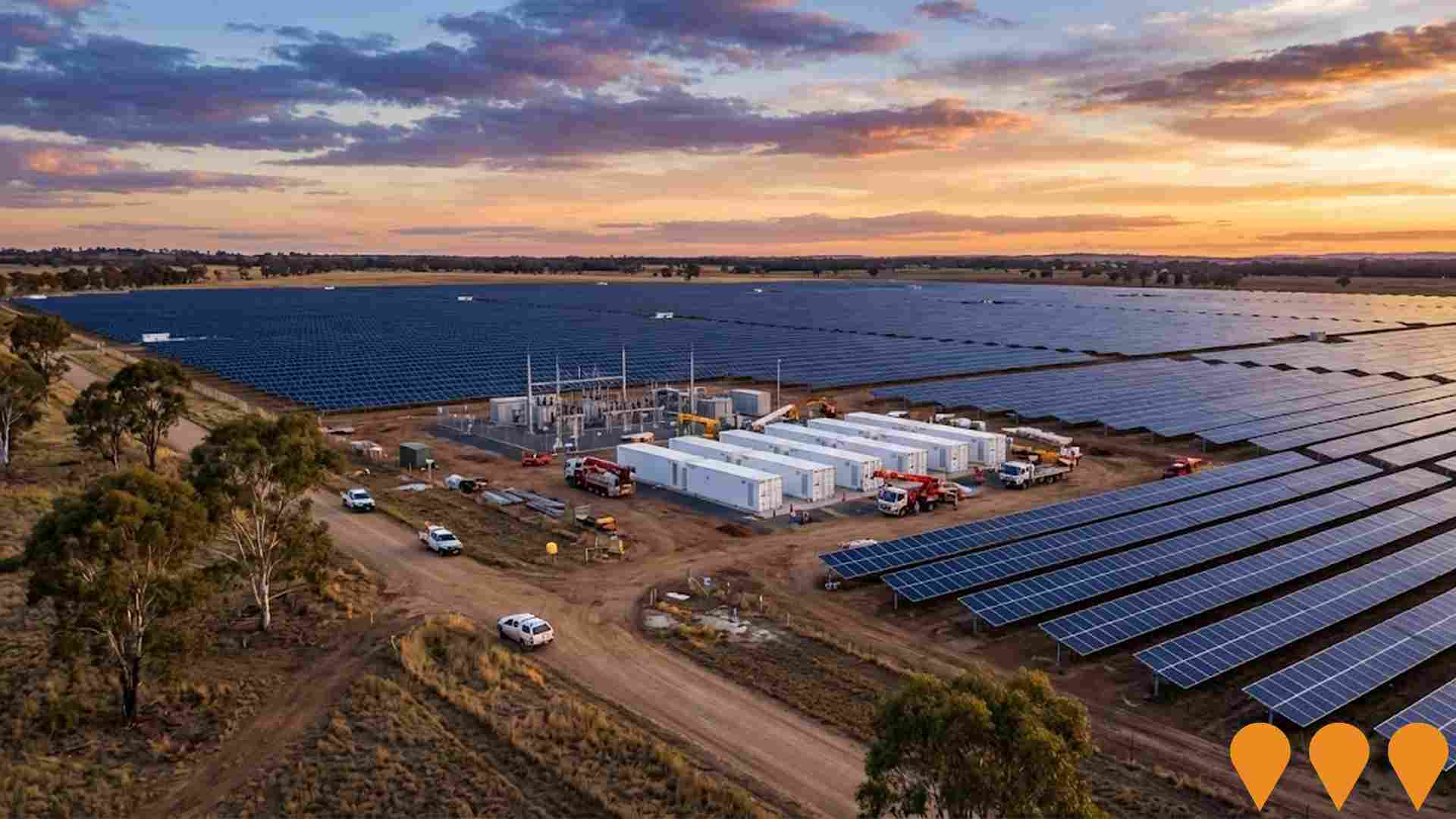Chart Color Schemes
est. as @ -- *
ABS ERP | -- people | --
2021 Census | -- people
Sales Activity
Curious about local property values? Filter the chart to assess the volume and appreciation (including resales) trends and regional comparisons, or scroll to the map below view this information at an individual property level.
Find a Recent Sale
Sales Detail
Population
Wellington is positioned among the lower quartile of areas assessed nationally for population growth based on AreaSearch's assessment of recent, and medium term trends
Wellington's population was around 9,182 as of Aug 2025. This reflected an increase of 413 people since the 2021 Census, which reported a population of 8,769 people. The change was inferred from the estimated resident population of 9,122 from the ABS as of June 2024 and an additional 48 validated new addresses since the Census date. This level of population resulted in a density ratio of 2.5 persons per square kilometer. Wellington's growth rate of 4.7% since the 2021 census exceeded both the SA4 region (3.2%) and the SA3 area, indicating it as a growth leader in the region. Overseas migration contributed approximately 43.1% of overall population gains during recent periods, with other drivers such as interstate migration and natural growth also being positive factors.
AreaSearch adopted ABS/Geoscience Australia projections for each SA2 area, released in 2024 with a base year of 2022. For areas not covered by this data, AreaSearch used the NSW State Government's SA2 level projections, released in 2022 with a base year of 2021. Growth rates by age group from these aggregations were applied to all areas for years 2032 to 2041. Considering projected demographic shifts, Wellington was expected to grow by just below the median of Australia's non-metropolitan areas, with an increase of 631 persons to 2041 based on the latest population numbers, representing a total increase of 6.2% over the 17 years.
Frequently Asked Questions - Population
Development
AreaSearch assessment of residential development drivers sees a low level of activity in Wellington, placing the area among the bottom 25% of areas assessed nationally
Wellington has averaged approximately 18 new dwelling approvals annually over the past five financial years, totalling 92 homes. As of FY-26, 12 approvals have been recorded. Over these five years, an average of 1.1 people per year moved to the area for each dwelling built. However, this figure has increased to 10.7 people per dwelling over the past two financial years, indicating Wellington's growing popularity and potential supply constraints. New properties are constructed at an average expected cost of $475,000.
In FY-26, $5.8 million in commercial approvals have been registered, reflecting the area's primarily residential nature. Compared to the Rest of NSW, Wellington records significantly lower building activity, with 64.0% fewer approvals per person. This scarcity typically strengthens demand and prices for existing properties. Recent construction comprises 83.0% detached dwellings and 17.0% townhouses or apartments, maintaining the area's traditional low density character focused on family homes. The estimated population count per dwelling approval is 1074 people.
Population forecasts indicate Wellington will gain approximately 571 residents by 2041. At current development rates, new housing supply should comfortably meet demand, providing good conditions for buyers and potentially supporting growth beyond current population projections.
Frequently Asked Questions - Development
Infrastructure
Wellington has emerging levels of nearby infrastructure activity, ranking in the 35thth percentile nationally
Changes in local infrastructure significantly affect an area's performance. AreaSearch has identified 32 projects that could impact this region. Notable ones include Wellington Roads To Home Project Nanima Village, Wellington Battery Energy Storage System, Orana Battery Energy Storage System, and Wellington North Solar Farm. The following list details those most likely to be relevant.
Professional plan users can use the search below to filter and access additional projects.
INFRASTRUCTURE SEARCH
 Denotes AI-based impression for illustrative purposes only, not to be taken as definitive under any circumstances. Please follow links and conduct other investigations from the project's source for actual imagery. Developers and project owners wishing us to use original imagery please Contact Us and we will do so.
Denotes AI-based impression for illustrative purposes only, not to be taken as definitive under any circumstances. Please follow links and conduct other investigations from the project's source for actual imagery. Developers and project owners wishing us to use original imagery please Contact Us and we will do so.
Frequently Asked Questions - Infrastructure
Central-West Orana Renewable Energy Zone (REZ) Transmission Project
Australia's first coordinated Renewable Energy Zone transmission project. Delivers new 500 kV and 330 kV lines, energy hubs and substations across approximately 20,000 km2 in central-west NSW. ACEREZ consortium (Acciona, Cobra, Endeavour Energy) appointed as the Network Operator for design, construction, financing, operation and maintenance over 35 years. Initial network capacity of 4.5 GW, expanding to 6 GW by 2038. Construction commenced June 2025, with staged commissioning from 2027 and full operations targeted for 2028-2029. Project reached financial close in April 2025.
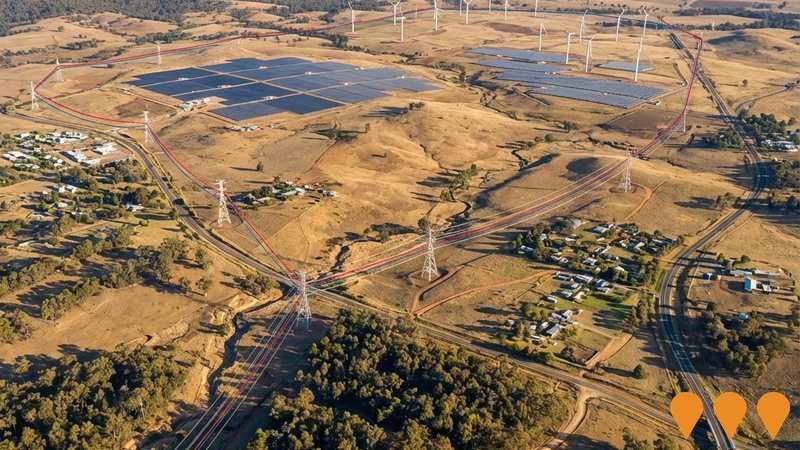
Spicers Creek Wind Farm
A 700 MW wind farm of up to 117 wind turbines with a 400 MW / 1800 MWh battery energy storage system in the Central-West Orana Renewable Energy Zone, located 25km northwest of Gulgong and 35km northeast of Wellington. NSW Independent Planning Commission granted development consent on 31 October 2024, Commonwealth EPBC approval was granted on 6 March 2025, and the project was selected for the Capacity Investment Scheme in December 2024. Expected to power approximately 395,000 homes and reduce emissions by 650,000 tonnes annually.

Phoenix Pumped Hydro Project
The Phoenix Pumped Hydro Project is an 800 MW off-stream pumped hydro energy storage facility developed by ACEN Australia, capable of delivering 800 MW for up to 15 hours (approximately 12,000 MWh total storage). Located on WaterNSW and adjacent private land on the eastern side of Burrendong Dam near Yarrabin (35 km west of Mudgee) in the Central-West Orana REZ. Features purpose-built upper and lower reservoirs (each ~50 ha), underground powerhouse, and tunnel connection. The project secured a Long-Term Energy Service Agreement (LTESA) in February 2025 and is currently preparing its Environmental Impact Statement (EIS), with construction targeted for ~2027 and operations in the early 2030s.
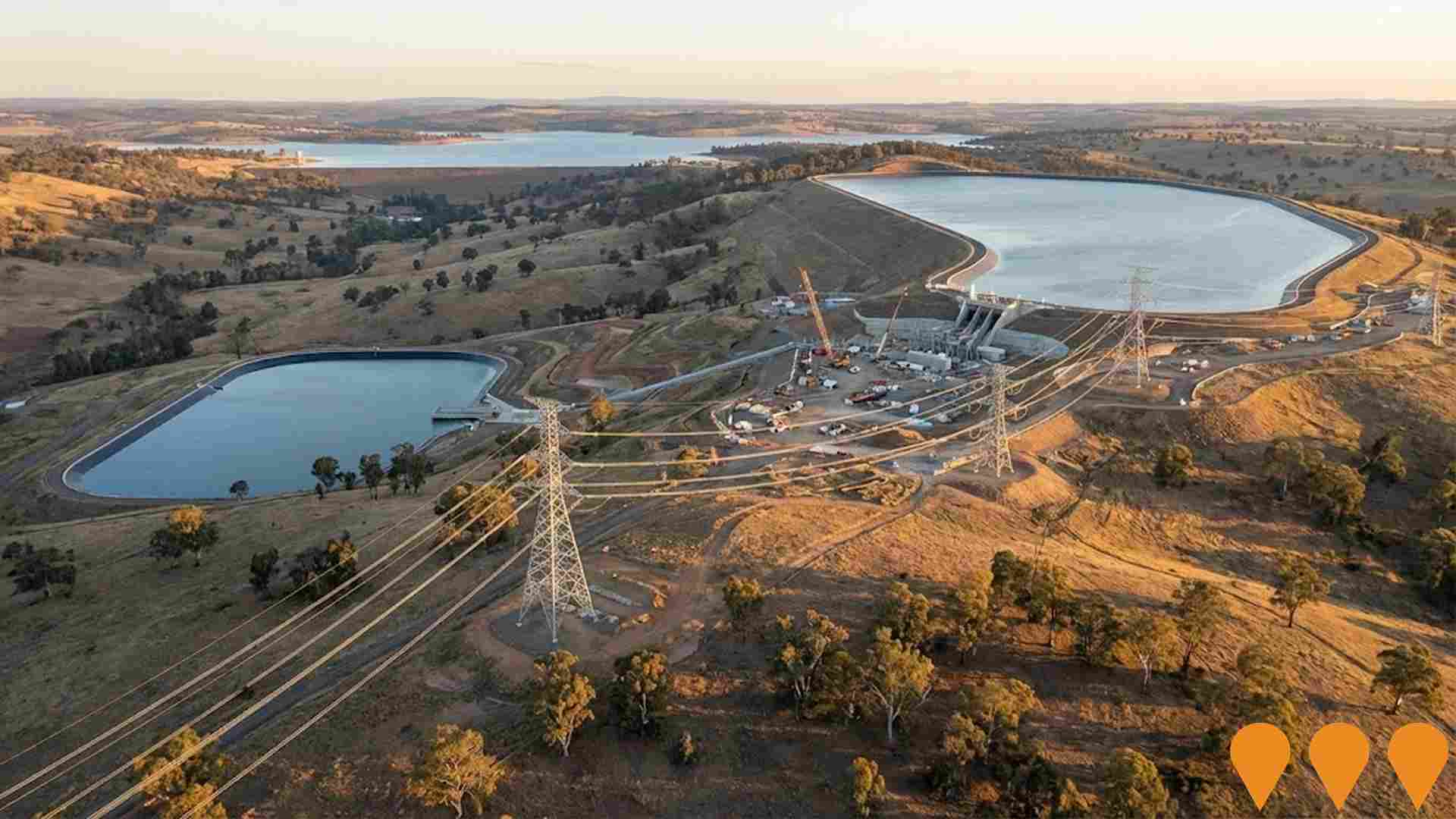
Wellington Roads To Home Project Nanima Village
The NSW Roads to Home Program is a NSW Government initiative to upgrade infrastructure in discrete Aboriginal communities. The Wellington Nanima Village project involves civil construction works for subdivision certification, including road and footpath reconstruction, new stormwater and water mains, sewer upgrades, and landscaping for the 21-dwelling community. The program aims to provide municipal services to appropriate standards, improve social and economic connections, and reduce health hazards.

Wellington North Solar Farm
The Wellington North Solar Farm is a 425MWdc solar farm developed by Lightsource BP, located approximately seven kilometres north-east of Wellington off Goolma Road in the Central-West Orana region of NSW. The project uses 1.2 million bifacial solar panels and creates a solar hub with the adjacent 200MWdc Wellington Solar Farm for a combined capacity of 625MWdc. The project includes 155 inverter stations and connects to TransGrid's Wellington substation via a 2.4km 330kV transmission line. Construction creates 400 jobs with completion expected by 2024, generating enough electricity to power approximately 170,000 Australian homes annually.
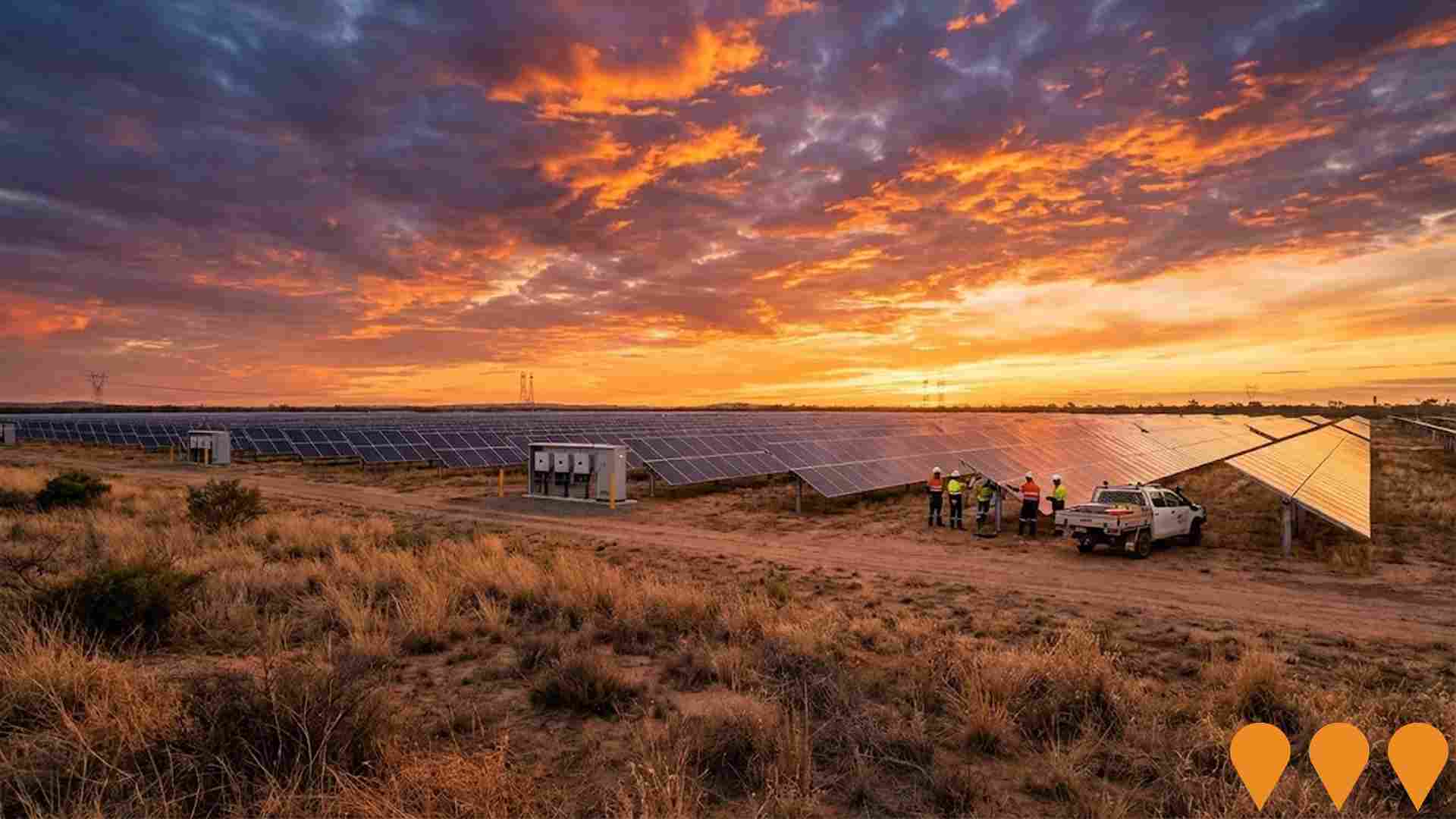
Boree Solar Farm
A 250 MW solar photovoltaic farm with a 150 MW/800 MWh battery energy storage system spanning 1322 hectares. The project is expected to power approximately 96,000 homes and reduce greenhouse gas emissions by about 11,450,000 tonnes over 30 years. Located within the Central West Orana Renewable Energy Zone, the project is currently in the planning stage with a Scoping Report to be submitted to the Department of Planning, Housing and Infrastructure in Q2 2025.
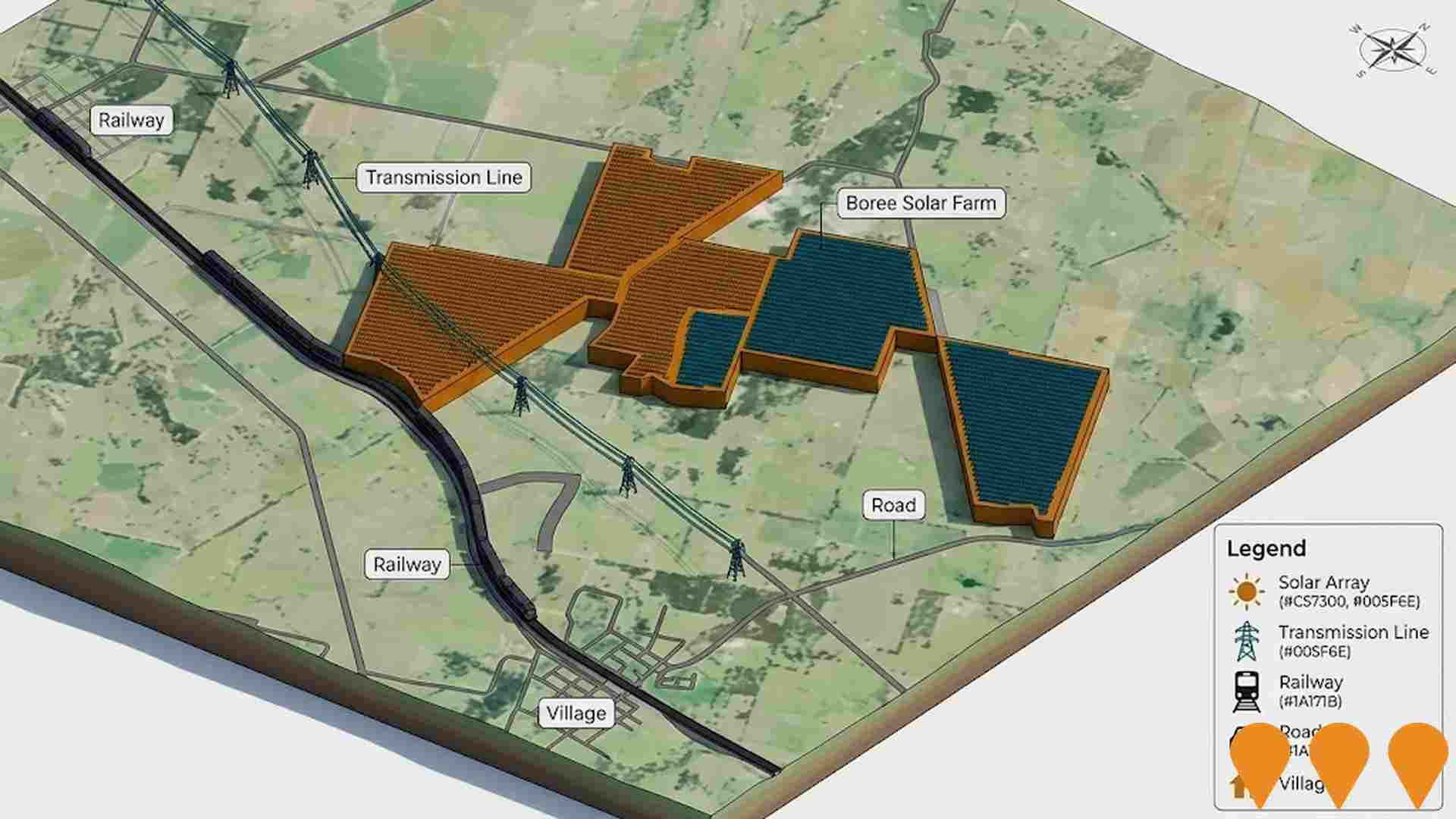
Orana Battery Energy Storage System
Akaysha Energy is delivering a grid-scale battery near Wellington within the Central West Orana REZ. The Orana BESS is sized at about 415 MW / 1,660 MWh (four-hour duration) with associated connection works adjacent to the TransGrid 330 kV network. Development consent was granted in December 2023, subsequent modifications have been approved, financing has closed, and site works have commenced.
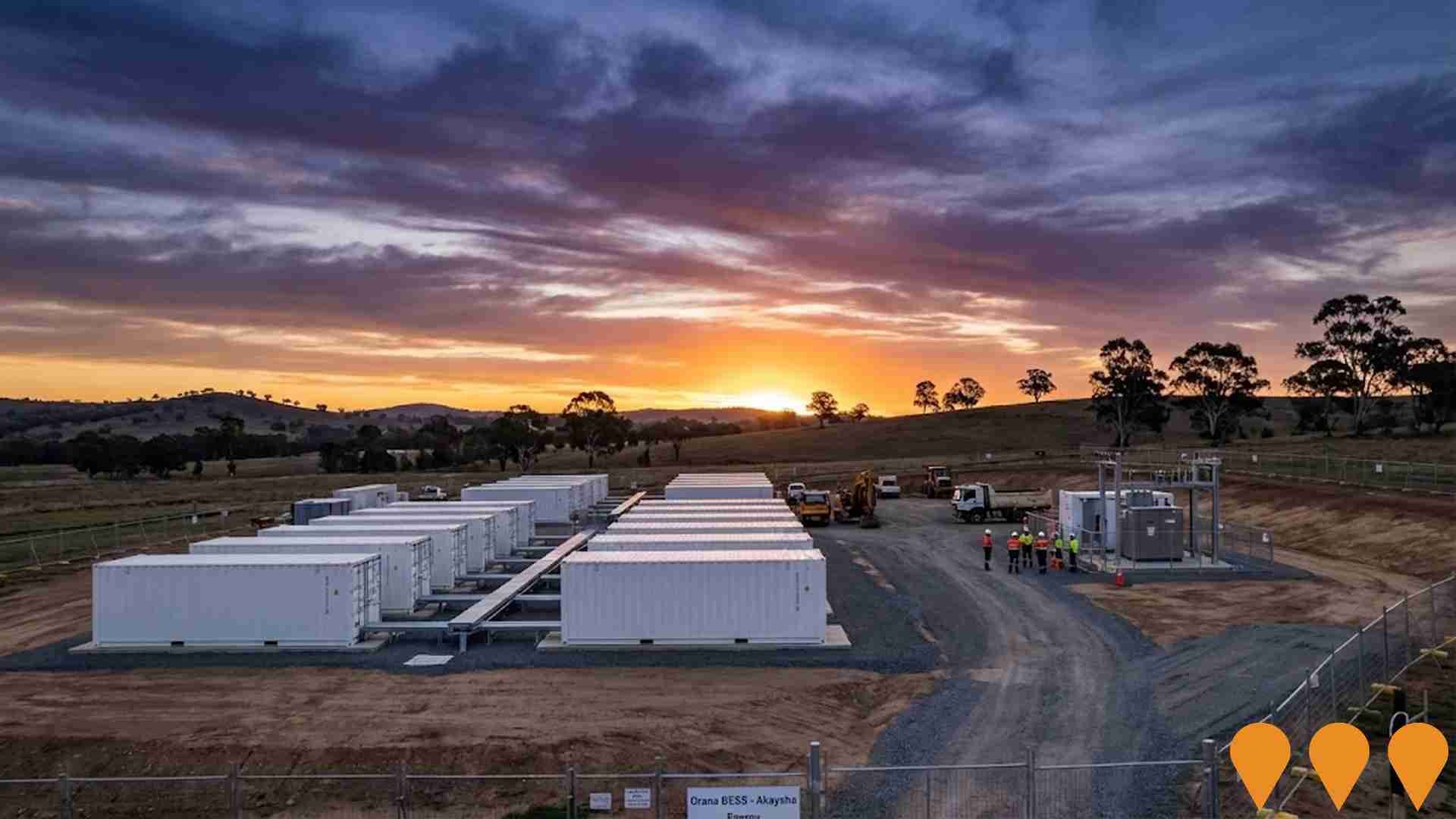
Burrendong Wind Farm
Ark Energy is proposing a 500 MW wind farm with up to 70 wind turbines (each up to 250 m tall, 6-7 MW capacity) in Yarrabin, NSW, within the Central-West Orana Renewable Energy Zone. Key components include internal roads and drainage, up to two substations, one O&M compound, 33 kV electrical connections, up to three permanent meteorological masts, temporary facilities, and connection to the existing TransGrid 330 kV transmission line west of Lake Burrendong. The project has a 30-year operational lifespan. EIS exhibited Nov-Dec 2023; Submissions Report and Amendment Report lodged Dec 2024. Currently under assessment by NSW Department of Planning (SSD-8950984).
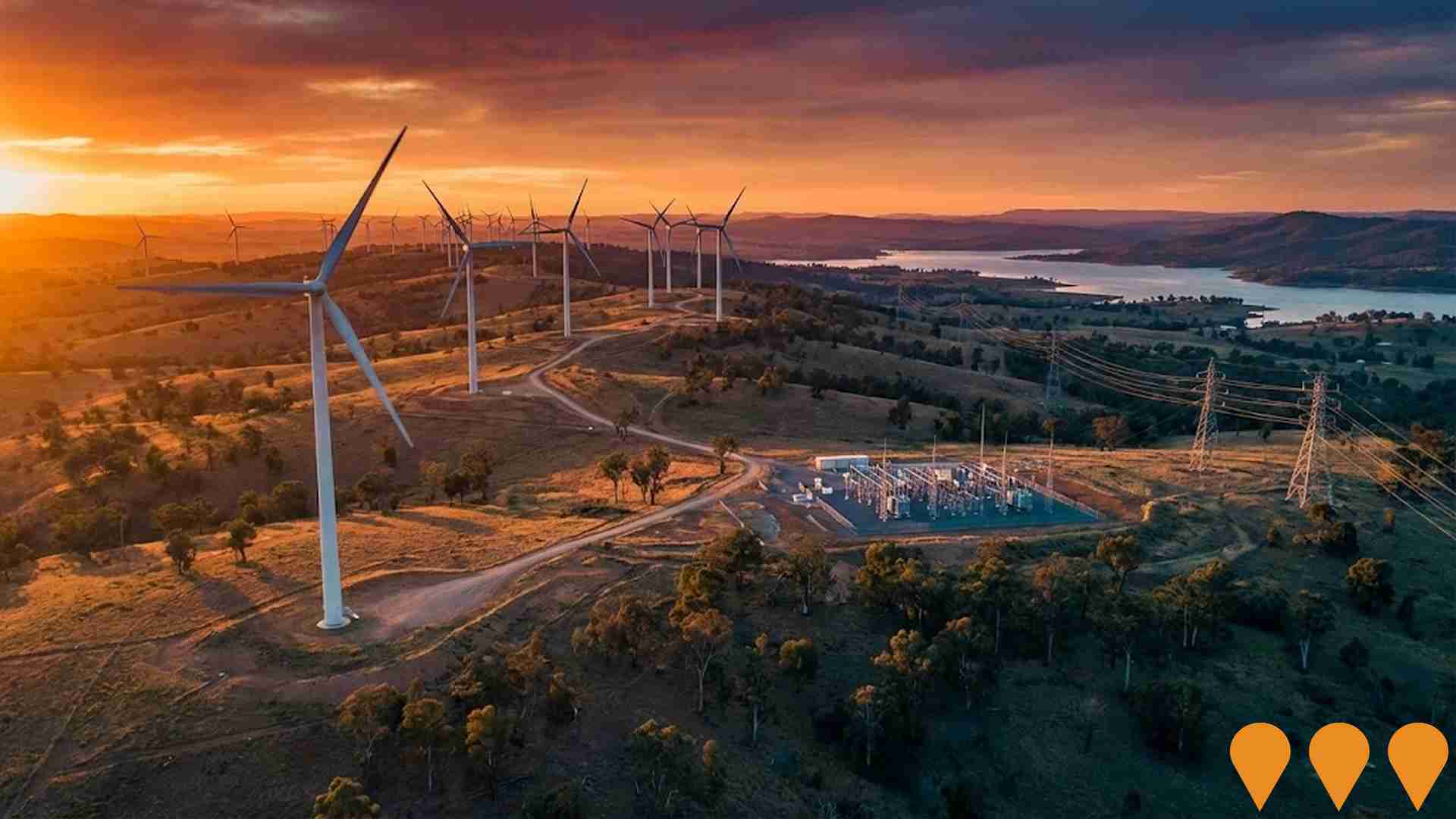
Employment
AreaSearch assessment indicates Wellington faces employment challenges relative to the majority of Australian markets
Wellington has a balanced workforce with both white and blue collar jobs. Key sectors include agriculture, forestry & fishing, health care & social assistance, and public administration & safety.
As of June 2025, the unemployment rate is 4.6%. Wellington's unemployment rate is 1.0% higher than Rest of NSW's rate of 3.7%, and workforce participation is lower at 46.0% compared to Rest of NSW's 56.4%. A total of 3,352 residents are employed. The area shows strong specialization in agriculture, forestry & fishing, with an employment share of 2.9 times the regional level.
However, manufacturing employs only 2.7% of local workers, below Rest of NSW's 5.8%. Between June 2024 and May 2025, Wellington's labour force decreased by 1.9%, while employment decreased by 3.3%, leading to a rise in unemployment rate by 1.4 percentage points. In contrast, Rest of NSW saw employment contract by 0.1%, labour force grow by 0.3%, and unemployment rise by 0.4 percentage points. Jobs and Skills Australia's national employment forecasts from May 2025 project national employment growth of 6.6% over five years and 13.7% over ten years. Applying these projections to Wellington's employment mix suggests local growth of approximately 5.9% over five years and 12.5% over ten years.
Frequently Asked Questions - Employment
Income
The area's income levels rank in the lower 15% nationally based on AreaSearch comparative data
AreaSearch's latest postcode level ATO data for financial year 2022 shows that Wellington's median income is $44,471 and average income is $50,647. This is below the national average. In contrast, Rest of NSW has a median income of $49,459 and an average income of $62,998. Based on Wage Price Index growth of 12.61% since financial year 2022, current estimates for Wellington would be approximately $50,079 (median) and $57,034 (average) as of September 2025. According to the 2021 Census, household, family, and personal incomes in Wellington fall between the 10th and 14th percentiles nationally. The earnings profile shows that 27.3% of locals (2,506 people) earn between $800 and $1,499, differing from metropolitan regions where the predominant earning category is $1,500 to $2,999 at 29.9%. Despite modest housing costs allowing for 87.9% income retention, Wellington's total disposable income ranks at only the 15th percentile nationally.
Frequently Asked Questions - Income
Housing
Wellington is characterized by a predominantly suburban housing profile, with above-average rates of outright home ownership
Wellington's dwelling structures, as per the latest Census, consisted of 93.5% houses and 6.5% other dwellings (semi-detached, apartments, 'other' dwellings). This compares to Non-Metro NSW's 88.0% houses and 12.1% other dwellings. Home ownership in Wellington stood at 42.7%, with mortgaged dwellings at 30.1% and rented ones at 27.2%. The median monthly mortgage repayment was $1,100, below Non-Metro NSW's average of $1,450. The median weekly rent figure was $230, compared to Non-Metro NSW's $280. Nationally, Wellington's mortgage repayments were significantly lower than the Australian average of $1,863, and rents were substantially below the national figure of $375.
Frequently Asked Questions - Housing
Household Composition
Wellington features high concentrations of lone person households, with a lower-than-average median household size
Family households constitute 65.2% of all households, including 22.1% couples with children, 27.8% couples without children, and 13.8% single parent families. Non-family households comprise the remaining 34.8%, with lone person households at 31.7% and group households at 3.1%. The median household size is 2.4 people, which is smaller than the Rest of NSW average of 2.5.
Frequently Asked Questions - Households
Local Schools & Education
Wellington faces educational challenges, with performance metrics placing it in the bottom quartile of areas assessed nationally
The area's university qualification rate is 15.4%, significantly lower than the NSW average of 32.2%. Bachelor degrees are most common at 11.7%, followed by postgraduate qualifications (2.0%) and graduate diplomas (1.7%). Vocational credentials are held by 44.8% of residents aged 15+, with advanced diplomas at 10.2% and certificates at 34.6%. Educational participation is high, with 37.2% currently enrolled in formal education: 15.1% in primary, 10.8% in secondary, and 2.8% in tertiary education.
Wellington has a network of 9 schools educating approximately 1,146 students, comprising 6 primary, 1 secondary, and 2 K-12 schools. School places per 100 residents are 12.5, lower than the regional average of 16.2, indicating some students may attend schools in nearby areas.
Frequently Asked Questions - Education
Schools Detail
Nearby Services & Amenities
Transport
Transport servicing is moderate compared to other areas nationally based on assessment of service frequency, route connectivity and accessibility
Wellington has 307 active public transport stops, serving a mix of train and bus routes. These are serviced by 35 individual routes, offering 1,119 weekly passenger trips in total. Residents enjoy excellent transport accessibility, with an average distance of 177 meters to the nearest stop.
Service frequency across all routes averages 159 trips per day, equating to approximately 3 weekly trips per stop.
Frequently Asked Questions - Transport
Transport Stops Detail
Health
Health performance in Wellington is well below average with prevalence of common health conditions notable across both younger and older age cohorts
Wellington faces significant health challenges, as indicated by health data. Both younger and older age groups have a notable prevalence of common health conditions. The rate of private health cover is extremely low at approximately 46% of Wellington's total population (~4,242 people), compared to 49.7% across the rest of NSW and the national average of 55.3%.
The most common medical conditions in Wellington are arthritis and mental health issues, affecting 10.9 and 9.2% of residents respectively. However, 61.3% of residents report being completely clear of medical ailments, compared to 64.1% across the rest of NSW. Wellington has a higher proportion of seniors aged 65 and over at 20.5%, with 1,885 people in this age group, compared to 19.5% in the rest of NSW. Health outcomes among seniors present some challenges, broadly aligning with the general population's health profile.
Frequently Asked Questions - Health
Cultural Diversity
The latest Census data sees Wellington placing among the least culturally diverse areas in the country when compared across a range of language and cultural background related metrics
Wellington's cultural diversity was found to be below average, with 78.6% of its population being citizens, born in Australia at a rate of 91.6%, and speaking English only at home at 96.5%. Christianity was the predominant religion, accounting for 65.6% of Wellington's population, similar to the rest of NSW (65.6%). The top three ancestral groups were Australian at 31.3%, English at 28.6%, and Australian Aboriginal at 15.2%.
Notably, Irish ancestry was overrepresented in Wellington at 7.8% compared to the regional average of 8.2%, while French ancestry was present at 0.4%, slightly higher than the regional rate of 0.3%.
Frequently Asked Questions - Diversity
Age
Wellington's median age exceeds the national pattern
Wellington's median age is 41 years, which is lower than the Rest of NSW average of 43 but higher than the national average of 38. The 25-34 age group comprises 13.9% of Wellington's population, compared to a higher percentage in the Rest of NSW. The 75-84 age group makes up 6.8% of Wellington's population. According to post-2021 Census data, the 35 to 44 age group has increased from 11.6% to 12.5% of Wellington's population, while the 55 to 64 cohort has decreased from 13.6% to 12.9%. Demographic modeling indicates that by 2041, Wellington's age profile will change significantly. The 35 to 44 age group is projected to grow by 18%, adding 208 residents to reach a total of 1,353. Conversely, population declines are expected for the 15 to 24 and 65 to 74 age groups.
